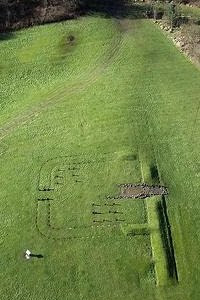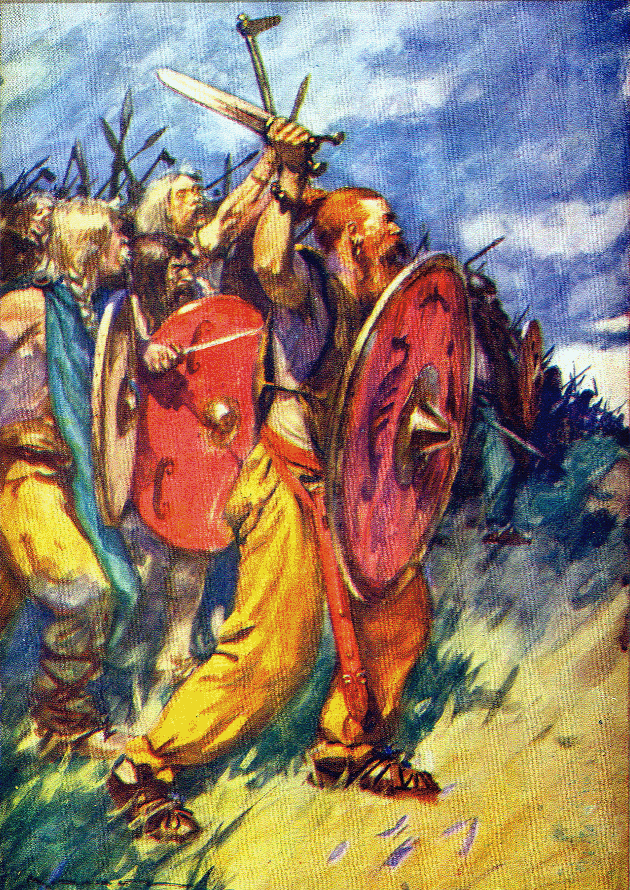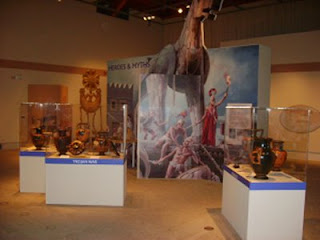There are a handful of perennially favourite themes in Roman history. One of them was the subject of my post on The Lost Legion, which continues to attract comments, although it is now two-and-a-half years old.
The latest ridiculously lengthy comment was posted in four instalments (as if to underline the poster's megalomania complex) and signed with the mysterious code "45 CDO RM". Not being immediately familiar with current British Army abbreviations, I turned to Google, where one of the search results was a Hubpage, a bit like a blog, but hosted by a website called Hubpages. And there, lurking amongst pages about "Thigh High Stockings" and "10 Signs That He's No Good For You", was a page called "The Mystery of Legio IX Hispana" posted by "British Military". I hesitate to point you there, because it's just the usual nonsense (well, alright, you can read it here), but it is interesting that a story, no matter how fantastical, unlikely and completely unsupported by evidence, continues to exert such a hold on some people's imagination.
My latest correspondent makes a series of blunders, based on apparently commonly held but false beliefs, repeating the same Roman nonsense that I have previously warned against. So ... here goes again!
Proposal 1: "In the territory ( in modern Perthshire ), of a Pict tribe the Romans called the Vacomagi just below ( according to Ptolemy ), the territory of the Calidonii tribe, the IX Legion built a 53 acre 'great fortified camp' at Inchtuthil on the river Tay, called Pinnata Castra ( Fortress on the Wing )."
True or False? First, the Vacomagi weren't Picts, because the Picts didn't exist until the third century. Second, we don't know what the Ninth Legion built here, because they didn't sign any of their work. Third, the 53-acre fortress at Inchtuthil probably wasn't called Pinnata Castra. Fourth, Ptolemy records a "town" called Pterôton Stratopedon (he was writing in Greek), which a German scholar named Müller decided to translate as "Pinnata Castra" and a British scholar named Richmond decided to link with Inchtuthil. Fourth, there is no reason, no evidence, and no justification to link the Ninth Legion with either Inchtuthil or Pterôton Stratopedon.
Proposal 2: "In order to gain a wider control Agricola split his force into three groups. When Agricola split his force into three, the IX [ Ninth ] Legion - who seem to have been especially hated by the Picts perhaps because of some heinous act of brutality - became the Picts main target."
True or False? First, we have now backtracked from the likely date of Inchtuthil, around AD 84/6, to Agricola's sixth campaign, AD 82, so the argument is doomed to confusion from the start. But let's persevere. Second, the Ninth Legion were not especially hated by the Picts, because the Picts didn't exist until the third century. Third, the Ninth Legion hadn't perpetrated a heinous act of brutality on the Picts, because the Picts didn't exist until the third century. Fourth, the Ninth Legion didn't become the Picts' main target, because (you guessed) the Picts didn't exist until the third century.
Proposal 3: "The Caledonians carried out a daring attack in the dead of night on the fortress of the sleeping Ninth Legion. They first set bodies of troops at key positions to intercept any fleeing Legionnaires and then advance units overpowered the guards. It seems the advance attackers managed to open the main gates allowing the waiting united Pict army to pour into the camp in their thousands, there may have been as many as 20,000 or 30,000 of them. Agricola eventually came to the rescue with cavalry units just in time to save the remnants of the IX; if not for his actions the Legion might have become extinct at that point."
True or False? First, we're back in AD 82, prior to the construction of the fortress at Inchtuthil, so the Ninth Legion weren't camping in a fortress. Second, there weren't any "legionnaires", because the French Foreign Legion weren't involved; only Roman legionaries. Third, the advance party of the Caledonians (aha! so not the Picts) didn't have any gates to open, because Roman temporary camps don't have gates. Fourth, it is highly unlikely that there would even have been room for 20,000 or 30,000 warriors to pour through a 10m wide gap in the rampart of a camp, but that's just my opinion. Fifth, the Ninth Legion had had brushes with disaster before, but I concede that a major defeat could have been on the cards.
Proposal 4: "The Romans couldn't simply reinforce the IX from other units, probably because more than half the Ninth Legion had been lost. They had to bring in a replacement Legion, pull the remnants of the IX out of Caledonia, re-form the whole Legion and repopulated it with new recruits and officers."
True or False? This time, we have stumbled deep into fantasy land. I seem to recall something similar on Mr Albawest's web site (noted here). First, more than half the Ninth Legion had been lost? Well, we can imagine it got mauled, but we have no idea how badly, and it's interesting to remember that 25 years earlier, after a similar mauling, it had received 2,000 new recruits. Serious, but not too serious. Second, there is no evidence, zero, nil, nothing to suggest that a replacement legion was brought in. Third, there is no evidence, zip, nada, to suggest that the Ninth Legion was evacuated. So, this is really just fantasy.
Proposal 5: "The Emperor of Rome marshalled a renewed Ninth Legion and after the recall of Agricola back to Rome, he sent them for a few years of training and campaigning to battle harden them. The Emperor then sent them to teach the Caledonians a lesson about the power of Rome. The new IX Hispana Legion proudly marched north - and simply disappeared. Not one trace has ever been found of them or any of their equipment."
True or False? After proposal 4, we are so far into fantasy that facts don't matter any more, but we'll have a go. First, how would we even demonstrate that a legion had been withdrawn, retrained and battle-hardened? This is a non-starter. Second, how would we show that the Ninth Legion had returned after a period of absence? And third, how would we prove that a legion had disappeared in Scotland? Think about it. This is pure fantasy. But fourth, and most importantly, we do have traces of the legion after AD 82. Long after AD 82.
Proposal 6: "Some historians have claimed that the IX was pulled out of Caledonia but the Romans forgot to record that fact. However, the Romans did not loose a Legion in the paperwork; something terrible seems to have happened to the IX, it is as if they just ceased to exist."
True or False? Well, having got lost so deeply in fantasyland, it's going to be difficult to extricate ourselves. First, every serious historian has claimed that the Ninth Legion was pulled out of Caledonia. After all, the entire Roman army was pulled out of Caledonia after around AD 86/7. So that's a given. Second, it's not a matter of the Romans forgetting to record the fact. After all, the historian Tacitus does record that Caledonia was given up. Nobody tried to hide the fact. And third, the Romans did occasionally lose legions, but on the battlefield, not in the paperwork. So, my correspondent is right: "it's as if the Ninth just ceased to exist", but just not yet. Archaeologists have shown that they were happily in garrison in York in AD 108, which is rather a long time after their supposed demise in Caledonia. Their disappearance must have occurred some time later.
Proposal 7: "the Picts annihilated the IX and captured the Legion's Standard and so the disgraced remnants of the Legion were disbanded, and all records of its fate were erased. Roman policy was not to publicly record the fate of legions that had been disgraced or annihilated in battle."
False or Fantastical? First, the Ninth wasn't annihilated by the Picts (oh, dear, we're back with the Picts), because they didn't exist until the third century. Second, nobody (not even the Picts) captured the legion's standard. How would we even know this? Rubbish! And third, it's rather convenient, when there's no evidence for an event, to claim that all records of it were erased! Nonsense! And fourth, it's complete fiction to claim that the fate of a destroyed legion was never recorded. How do we know about Varus' legions in AD 9? But when you're this far into fantasyland, anything goes.
Proposal 8: "Modern claims that the IX have been rediscovered, could in fact be a different Legion with the same number. The disappearance of the Ninth Legion is one of the mysteries of the Roman Empire. Several scholars believe that it would have taken a major catastrophic event to cause the emperor Hadrian to decide to build his famous wall in modern England; they argue that the catastrophe was the annihilation of the IX legion by the Picts."
Fantastical or Really Fantastical? First, what's the point of claiming that the Ninth Legion was destroyed and disgraced, if you then suggest that a new duplicate legion was created, only to disappear again later? Second, no scholar (at least, none that I've ever heard of) has suggested that the building of Hadrian's Wall was in response to a military catastrophe. And definitely not the annihilation of the Ninth Legion, which (as we've established) wasn't annihilated at this time, and certainly not by the Picts. (Did I mention that the Picts didn't exist until the third century?)
And finally: Similarly preposterous claims are found on the Hubpage site that I mentioned before: "Alternatives to massacre are mutiny provoked by bad leadership and flight in the face of the enemy. The punishment for mutiny and cowardice was decimation of the Legion, disbandment, dispersion, removal from the army's list, and withdrawal of the Eagle." It's fun to suggest such counterfactual scenarios, as long as you acknowledge that they are fictional, and didn't actually happen. The fact is that the Ninth Legion was still fully functional in Britain in AD 108, long after the Romans had given up the idea of conquering Caledonia.
We know that the legion later turned up at Nijmegen in the Netherlands. If we acknowledge that fact, and give up all the "Pictish victory" nonsense, it is redundant to then suggest that "those sent to Nijmegen, probably from the Legion's rear party in York, may have defiantly continued to use the tile stamp to emphasise their own innocence in the affair." What affair? Are we still talking about this close call 25 years earlier, in AD 82?! Why not simply admit that, whatever happened to the Ninth Legion, it didn't happen in Britain, and it most definitely wasn't anything to do with the Picts.
(Did I mention that the Picts didn't exist until the third century?)
 Things are hotting up for the keenly-awaited cinematic version of Eagle of the Ninth.
Things are hotting up for the keenly-awaited cinematic version of Eagle of the Ninth. Scholars are sometimes tempted to step outside their area of expertise. This is almost always ill-advised.
Scholars are sometimes tempted to step outside their area of expertise. This is almost always ill-advised. A week or so ago, the BBC News web site
A week or so ago, the BBC News web site  After winning recognition as a World Heritage Site
After winning recognition as a World Heritage Site 
 I almost share a birthday with Samuel Johnson.
I almost share a birthday with Samuel Johnson. It is generally agreed that the building of
It is generally agreed that the building of 
 Colin Firth is no
Colin Firth is no  I have been thinking about salt.
I have been thinking about salt. I accidentally picked up a book called
I accidentally picked up a book called  Easter (as
Easter (as  The Greeks have landed at Glasgow's
The Greeks have landed at Glasgow's  A Roman emperor hunting for a topic to begin a new year naturally seizes upon Janus, the god of doorways.
A Roman emperor hunting for a topic to begin a new year naturally seizes upon Janus, the god of doorways.